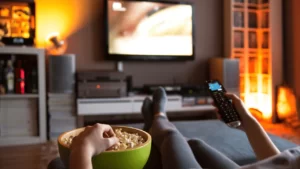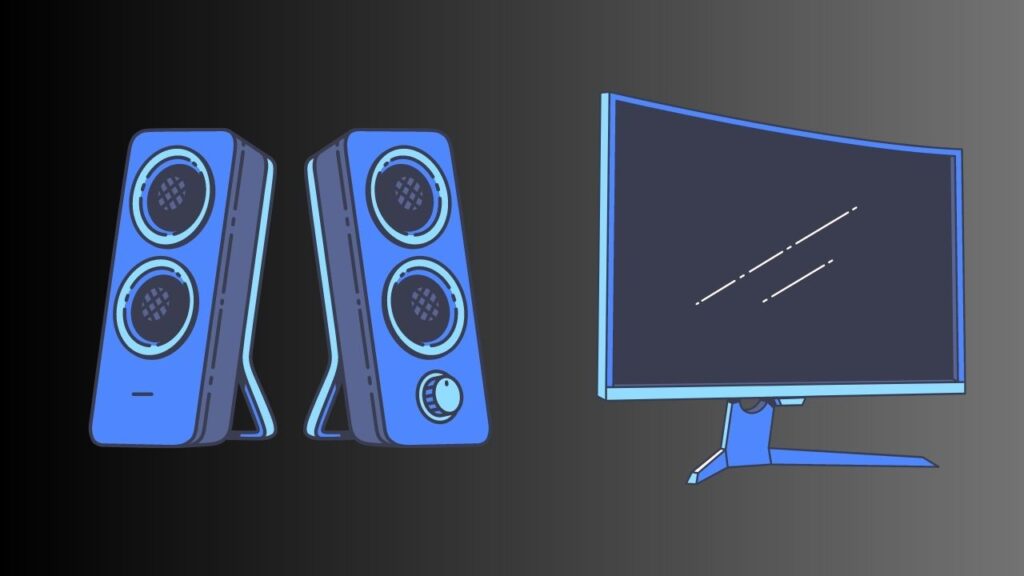You can find multiple ways to connect an external speaker to the monitor. You can use an HDMI audio extractor, an optical connection on the monitor, or any adapter to connect the monitor and speaker.
But, before connecting, you must check whether the external device is functional and keep your computer’s sound driver up to date. Also, confirm whether the volume is not muted.
If you have multiple input devices, try using an HDMI splitter. Otherwise, a 3.5 mm output audio makes connecting any external speaker to the monitor easier.
So, let’s have a look at the 5 ways – how you can connect speakers to monitors.
Is your Speaker an Active or a Passive one?
Check if your speaker is an active or passive variant. If it is an active variant, it will have a pre-installed amplifier. The bonus point is that you can connect it directly to the monitor.
But, if it is a passive one, then it would have dedicated cables. So, before connecting them to the monitor, you need to plug the cables into the amplifiers.
Does your monitor have a dedicated audio output port? Yes! Then, check whether it is digital ports – HDMI ARC/Optical Out, or analog ones – AUX/RCA OUT.
Remember, the monitors can have both input and output ports. Here, the input ports receive signals from external sources, and the output ports send out signals.
This information can help you to connect the speaker to the monitor within minutes.
How to Connect Speakers to Monitors in 5 Ways?
1. Build a direct connection
You can directly connect the external speaker to the respective monitor, which has a built-in audio port.
There are multiple types of audio-output port interfaces. So, all you have to do is identify the accurate one that might be best suited for you.
- First, based on the availability of the port type, you need to choose the cable.
- Find the back panel by tilting the monitor, or for safety, you can also turn it around.
- Insert the jack in the correct audio port and check if the link is stable.
- Now, plug the other end of the connector into the input audio port of the speaker.
It’s time to test the external speakers. It should start immediately after a successful connection is established.
However, if it fails and the speaker does not work, you must solve the problem manually.
Go to the system tray and click the Speakers icon from the Windows taskbar. Right beside the volume slider, select the icon ‘Manage audio devices’, and select the speaker that you want to connect. Finally, verify whether it is working.
2. Use HDMI audio extractor
The latest models of monitors usually have one HDMI output port. This HDMI audio extractor connects an external speaker to the monitor.
- Connect both the audio extractor and the external speaker to the power source.
- Locate the HDMI output of the monitor and connect it to the HDMI cable.
- The other end of the HDMI cable should connect with the extractor’s HDMI IN.
- Plug one end of the applicable cable into the input port of the speaker. The other end goes to the extractor’s output port.
When the connection is established successfully, turn on the monitor and test the audio of the external speaker.
3. Connect the speaker using Bluetooth
If your monitor supports Bluetooth, then you can connect multiple speakers without the need for a cable.
- First, manually confirm whether the monitor supports wireless technology.
- Go to the monitor setting, and you will find a dedicated button either on the back side of the device or at the bottom.
- Connect the external speaker to the power source and turn on the device.
- Double-check if Bluetooth is enabled (usually, the configuration varies from speaker model to speaker).
- Long press the power button to check whether the device is visible.
If this is not working, you need to go through the dedicated guide that came with the device.
- Go to your monitor screen, and enable Bluetooth using the dedicated button.
- Go through the list of available devices that appear on the screen.
- Choose the speaker for which you want to establish the connection.
- Now try to play a song and test the connectivity and sound quality of the speaker.
4. Using a USB audio card
USB audio cards usually have LINE-In and LINE-OUTPUT, which are meant for connecting external speakers. You can establish a secure connection between the external speaker and monitor if your monitor has USB and AUX ports.
- First, connect the speaker to a power source.
- Locate the monitor USB port and insert the USB audio card.
- Take the audio cable and insert one end into the output port of the speaker.
- The other end is plugged into the AUX-IN port of the sound card.
Tes the audio quality of the external speaker by playing either a video or any audio file.
5. Use adapters and converters
If the audio ports on the speaker and monitor are incompatible, you must use the adapter for proper connection establishment.
So, if your speaker has an AUX input port, you can go for an RCA output port to build AUX to RCA adapter connectivity.
- Locate the AUX input port of the external speaker and plug in the AUX male connector.
- Plug the respective RCA connectors on the monitor’s white and red RCA output ports.
- You do not need to connect the yellow connector because it is meant for video output.
- Connect to the power source and test whether clear audio is audible from the external speakers.
If the audio speaker has an analog interface and your monitor has a digital audio output port, you must establish a connection between the digital-to-analog audio converter.
- Connect both the converter and the speaker to any stable power source.
- Take one end of the cable and insert it into the input port of the converter.
- The other end of the cable fits right into the digital audio output port of the monitor.
- Similarly, take one end of the plug and insert it into the output port of the converter.
- The other end is meant for the AUX-IN port of the speaker.
When you are done with establishing connectivity, try to play music to check whether the speakers are working appropriately.
Conclusion
These days monitors come with built-in speakers, and they are better optimized. But, if you prefer to connect an external speaker to your monitor for quality assurance, you must learn the correct process. These steps, mentioned above, would help you with how to connect speakers to a monitor.




